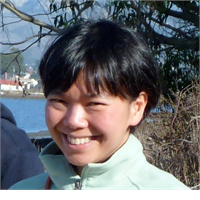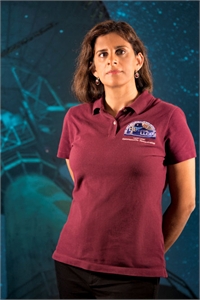Latest Past Events
Ground-Based and Space Telescopes: Current and Future
MIT Lincoln Lab 3 Forbes Road, LexingtonDr. Jane Luu MIT Lincoln LaboratoryThe talk will be about the needs for space and ground-based telescopes, and the technologies that make them possible. Half of the talk will focus on the James Webb Space Telescope, the most ambitious space telescope to date, and its successors. The other half will be about the largest ground-based telescopes (current and future).Dr. Jane Luu got her BS in Physics from Stanford and PhD in Planetary Astronomy from MIT in 1992. After receiving her doctorate, Luu worked as a professor at Harvard University, since 1994.Luu also served as a professor at Leiden University in the Netherlands. Following her time in Europe, Luu returned to the United States and works on instrumentation as a Senior Scientist at Lincoln Laboratory at MIT. In 2012, she won (along with David C. Jewitt of the University of California at Los Angeles) the Shaw Prize "for their discovery and characterization of trans-Neptunian bodies, an archeological treasure dating back to the formation of the solar system and the long-sought source of short period comets" and the Kavli Prize (shared with Jewitt and Michael E. Brown) "for discovering and characterizing the Kuiper Belt and its largest members, work that led to a major advance in the understanding of the history of our planetary system". Honors, awards, and accolades: 1991 Annie J. Cannon Award in Astronomy 2012 Shaw Prize in Astronomy 2012 Kavli Prize in Astrophysics The asteroid 5430 Luu was named in her honor on 1 July 1996 Fellow of the Norwegian Academy of Science and Letters. Registration is closed.
Enabling Exoplanet Direct Imaging with CubeSats
MIT Lincoln Lab 3 Forbes Road, LexingtonProf. Kerri Cahoy Massachusetts Institute of TechnologyCubeSats may be tiny and, and do not yet have apertures large enough to obtain high resolution images, but CubeSats can still enable progress in astronomy and astrophysics. For example, CubeSats can support technology demonstrations of promising new components, or they can augment the capability of a larger space telescope as a companion spacecraft. In this talk, we describe two of our projects, 1) the Deformable Mirror Demonstration Mission, DeMi, which will fly a MEMS deformable mirror along with Shack Hartmann and image plane wavefront sensors, and 2) the Laser Guide Star for Large Aperture Segmented Space Telescopes concept, where a companion CubeSat with a laser beacon flies at a safe distance from a large space telescope, while still in the field of view of the telescope's target. The CubeSat's reference beam allows faster stabilization of the space telescope, and results in access to more and dimmer targets for exoplanet direct imaging as well as relaxes stability requirements on the space telescope.Kerri Cahoy is an Associate Professor of Aeronautics and Astronautics at MIT and leads the Space Telecommunications, Astronomy, and Radiation (STAR) Laboratory. Cahoy received a B.S. (2000) in Electrical Engineering from Cornell University, and M.S. (2002) and Ph.D. (2008) in Electrical Engineering from Stanford University. Dr. Cahoy previously worked at Space Systems Loral, as a postdoctoral fellow at NASA Ames, and currently leads nanosatellite atmospheric sensing (MicroMAS, MiRaTA), optical communications (NODE, CLICK), and exoplanet technology demonstration (DeMi) missions.Registration is closed.
Laser Communication for NASA Mission
MIT Lincoln Lab 3 Forbes Road, LexingtonDr. Farzana Khatri MIT Lincoln LaboratoryTraditionally, communications between the Earth and space has relied on radio frequency (rf) systems, which have been in use since the Apollo era when sensor technology was primitive and the Internet did not exist. Today, commercial companies have deployed satellites with sensors that generate many Terabytes of data each day, but only a fraction of this data is transmitted back to earth due to communications bandwidth constraints. Furthermore, as humans venture deeper into space, higher communications bandwidth will be required to support them. Free-space laser communications, or “lasercom,” offers a high bandwidth and low Size Weight and Power solution to the space bandwidth bottleneck by using the same lasers and techniques which revolutionized fiber-optic communications in the 1990’s. This talk will describe the > 15 year collaboration between MIT LL and NASA in architecting and deploying lasercom systems, the current efforts to develop a strong industry base in lasercom, and upcoming lasercom missions.Farzana Khatri is a Senior Staff Member in the Optical Communication Technology group at MIT Lincoln Laboratory in Lexington, MA. She was a key player in NASA’s Lunar Laser Communication Demonstration (LLCD) project, a first-of-its-kind, record-breaking Moon to Earth free space laser communication system demo. Farzana is currently the Lead System Engineer for the lasercom links for NASA’s Laser Enhanced Mission Communications and Navigation Operational Service (LEMNOS) program. Farzana received the S.B., S.M., and Ph.D. degrees in Electrical Engineering and Computer Science from MIT in 1990, 1992, and 1996.Registration is closed.



